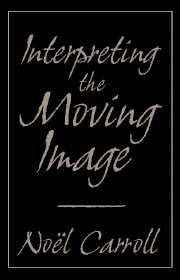Book contents
- Frontmatter
- Contents
- Foreword: Through Carroll's Looking Glass of Criticism
- Introduction
- 1 The Cabinet of Dr. Kracauer
- 2 Entr'acte, Paris and Dada
- 3 The Gold Rush
- 4 Keaton: Film Acting as Action
- 5 Buster Keaton, The General, and Visible Intelligibility
- 6 For God and Country
- 7 Lang, Pabst, and Sound
- 8 Notes on Dreyer's Vampyr
- 9 King Kong: Ape and Essence
- 10 Becky Sharp Takes Over
- 11 Interpreting Citizen Kane
- 12 The Moral Ecology of Melodrama: The Family Plot and Magnificent Obsession
- 13 Mind, Medium, and Metaphor in Harry Smith's Heaven and Earth Magic
- 14 Welles and Kafka
- 15 Nothing But a Man and The Cool World
- 16 Identity and Difference: From Ritual Symbolism to Condensation in Anger's Inauguration of the Pleasure Dome
- 17 Text of Light
- 18 Joan Jonas: Making the Image Visible
- 19 Introduction to Journeys from Berlin/1971
- 20 The Future of Allusion: Hollywood in the Seventies (and Beyond)
- 21 Back to Basics
- 22 Amy Taubin's Bag
- 23 Herzog, Presence, and Paradox
- 24 Film in the Age of Postmodernism
- Notes
- Index
22 - Amy Taubin's Bag
Published online by Cambridge University Press: 05 June 2012
- Frontmatter
- Contents
- Foreword: Through Carroll's Looking Glass of Criticism
- Introduction
- 1 The Cabinet of Dr. Kracauer
- 2 Entr'acte, Paris and Dada
- 3 The Gold Rush
- 4 Keaton: Film Acting as Action
- 5 Buster Keaton, The General, and Visible Intelligibility
- 6 For God and Country
- 7 Lang, Pabst, and Sound
- 8 Notes on Dreyer's Vampyr
- 9 King Kong: Ape and Essence
- 10 Becky Sharp Takes Over
- 11 Interpreting Citizen Kane
- 12 The Moral Ecology of Melodrama: The Family Plot and Magnificent Obsession
- 13 Mind, Medium, and Metaphor in Harry Smith's Heaven and Earth Magic
- 14 Welles and Kafka
- 15 Nothing But a Man and The Cool World
- 16 Identity and Difference: From Ritual Symbolism to Condensation in Anger's Inauguration of the Pleasure Dome
- 17 Text of Light
- 18 Joan Jonas: Making the Image Visible
- 19 Introduction to Journeys from Berlin/1971
- 20 The Future of Allusion: Hollywood in the Seventies (and Beyond)
- 21 Back to Basics
- 22 Amy Taubin's Bag
- 23 Herzog, Presence, and Paradox
- 24 Film in the Age of Postmodernism
- Notes
- Index
Summary
In the Bag (1981) is the first completed film of Amy Taubin, noted avant-garde critic, actress and performance artist. Roughly twenty minutes long, the film records a search through a tattered, patchwork-quilt shoulder bag for something – we know not what. Like Wavelength, a film many misremember as a single tracking shot, In the Bag is also easily misremembered and wrongly described as a stationary long take à la Warhol which relentlessly records Taubin's relentless rummaging. However, in fact, the film is intensively edited – full of what we come to understand as flash forwards, and cross-cuts between the primary search, set on a brown table, and an almost identical search, set on and amid the blue sheets of a bed. Taubin – her “cold/preoccupied” shoulder to the camera, her face generally occluded from us by her long brown hair – is the only person in the film; her manner is concentrated, suggesting a total obliviousness to onlookers. This plus her silence and the methodical character of her search gives In the Bag a meditative air which, in turn, places the film on a continuum with Taubin's solitary performance pieces – all solo meditations on the nature of the self.
Taubin began making theater pieces in 1978. These include Pimping for Herself (1975), Double Occupancy (1976), and Performance Which Began with a Train Ride on Which the Rider Realized but Not Until the Last Moment That She Had Been Seated Backward, Or Half of an Unbalanced Situation (1978).
- Type
- Chapter
- Information
- Interpreting the Moving Image , pp. 274 - 283Publisher: Cambridge University PressPrint publication year: 1998

